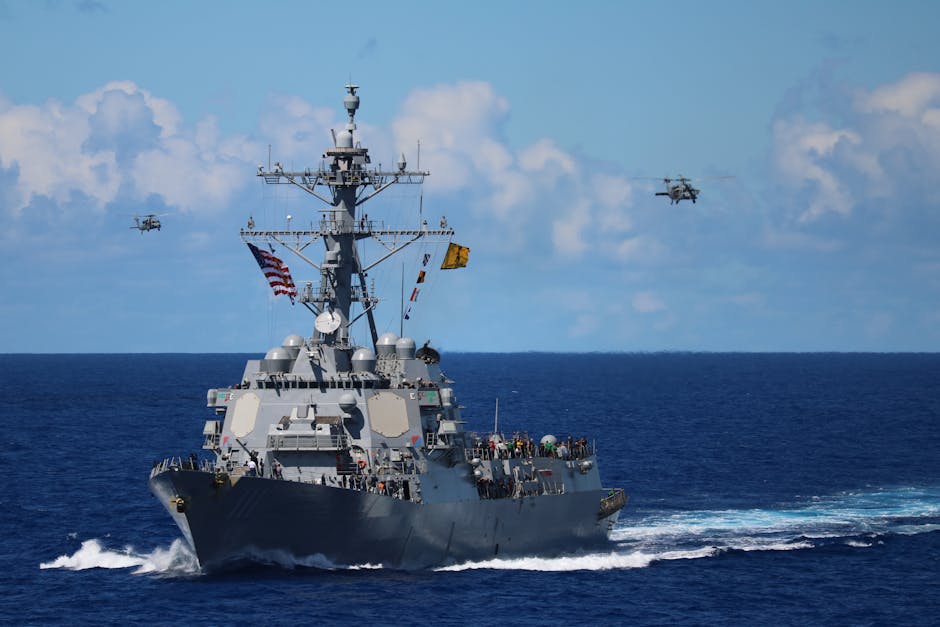Key Takeaways
- Destroyers are fast, maneuverable warships primarily designed for escort duties and anti-submarine warfare.
- Battleships are heavily armored and armed vessels intended for direct naval combat and shore bombardment.
- Destroyers emphasize speed and versatility, while battleships prioritize firepower and protection.
- The operational roles of destroyers and battleships reflect distinct naval strategies and technological eras.
- Modern navies have largely phased out battleships in favor of multi-role destroyers and cruisers equipped with missile systems.
What is Destroyer?

A destroyer is a fast, agile warship designed to protect larger vessels by countering threats such as submarines, aircraft, and smaller surface ships. These vessels play a crucial role in fleet defense and power projection in modern naval operations.
Role in Naval Strategy
Destroyers often serve as the shield of a naval fleet, providing anti-aircraft and anti-submarine defense that ensures the safety of high-value ships. Their speed and maneuverability allow them to rapidly respond to threats, making them indispensable in escort missions and patrols.
In modern naval doctrine, destroyers act as multi-mission platforms capable of launching guided missiles and coordinating with other units for integrated combat. Their flexibility enables fleets to adapt quickly to evolving tactical situations at sea.
Their ability to operate independently or as part of a carrier strike group reflects their strategic value in both offensive and defensive roles. This versatility has cemented destroyers as a backbone of contemporary naval forces worldwide.
Technical Specifications and Armament
Destroyers typically have displacements ranging from 6,000 to 10,000 tons and can reach speeds exceeding 30 knots. Their armaments include surface-to-air missiles, anti-ship missiles, torpedoes, and advanced radar and sonar systems.
Modern destroyers often feature vertical launch systems that enable rapid missile deployment for air defense and land attack missions. This technological sophistication allows them to engage multiple target types simultaneously.
Their weapon systems are complemented by electronic warfare suites and decoys to enhance survivability against guided missiles and torpedoes. Such comprehensive defense capabilities make destroyers formidable opponents in naval engagements.
Historical Evolution and Modern Usage
Originally developed in the late 19th century to counter torpedo boats, destroyers evolved through two world wars into multi-purpose combatants. Post-World War II, the advent of guided missiles significantly expanded their offensive and defensive roles.
Today’s destroyers incorporate stealth technology and automated systems to improve combat efficiency and reduce crew requirements. This evolution reflects the ongoing adaptation of destroyers to modern maritime threats and mission demands.
Navies like those of the United States, Japan, and South Korea operate advanced destroyers that serve as key elements in regional security architectures. Their global presence underscores the destroyer’s enduring significance in naval warfare.
Operational Flexibility and Deployment
Destroyers are capable of operating in diverse environments, from littoral zones to open oceans, supporting a wide range of missions. Their size and speed allow for rapid deployment in crisis situations, including humanitarian assistance and disaster relief.
Their onboard helicopters enhance anti-submarine warfare capabilities and expand reconnaissance reach. This combination of air and sea operations provides a tactical edge in complex maritime scenarios.
Many modern destroyers also integrate network-centric warfare systems, linking them with other naval and joint forces. This connectivity improves situational awareness and facilitates coordinated responses during multi-domain operations.
What is Battleship?

A battleship is a large, heavily armored warship equipped with powerful artillery designed for direct naval combat and shore bombardment. Once the dominant capital ship, battleships symbolized naval supremacy through their unmatched firepower and endurance.
Armament and Armor Characteristics
Battleships feature multiple large-caliber main guns capable of firing shells over long distances with devastating impact. Their thick armor plating protects vital areas against enemy fire, making them resilient in frontline engagements.
Their secondary batteries include medium-caliber guns and anti-aircraft weapons to defend against smaller vessels and aircraft. This layered defense system was crucial for surviving the combined threats faced during the first half of the 20th century.
Despite their heavy armor, battleships sacrificed speed and maneuverability, trading agility for superior protection and firepower. This design philosophy prioritized dominance in ship-to-ship gun battles.
Historical Significance and Decline
Battleships were the centerpiece of naval power from the late 19th century through World War II, exemplified by vessels like the USS Iowa and HMS King George V. Their ability to bombard coastal defenses and engage enemy fleets defined naval warfare during this period.
The rise of air power and missile technology during and after World War II rendered battleships increasingly vulnerable and obsolete. Aircraft carriers and missile-armed ships supplanted battleships as the preferred platforms for power projection.
By the late 20th century, many battleships were decommissioned or repurposed, marking the end of an era in naval history. Their legacy remains influential in the study of naval architecture and maritime strategy.
Strategic Role in Naval Engagements
Battleships served as command ships and deterrents, projecting national strength through their imposing presence. Their long-range guns supported amphibious assaults by suppressing enemy shore defenses.
Their ability to absorb heavy damage allowed fleets to maintain cohesion under fire, providing a stable core around which smaller vessels operated. This made battleships central to fleet tactics during major naval battles.
However, their operational limitations, including high crew requirements and fuel consumption, restricted their deployment flexibility. These factors contributed to their gradual replacement by more versatile warships.
Technological Features and Innovations
Throughout their development, battleships incorporated cutting-edge technologies such as fire-control systems and radar-guided artillery. These advancements enhanced targeting accuracy and combat effectiveness in complex conditions.
Innovations like the “all-or-nothing” armor scheme maximized protection while managing weight distribution. This design allowed battleships to withstand critical hits while maintaining buoyancy and combat readiness.
Despite these improvements, battleships struggled to adapt to new forms of warfare centered on air and missile threats. Their technological peak ultimately coincided with the dawn of a new naval era.
Comparison Table
The table below highlights key operational and design differences between destroyers and battleships, reflecting their unique contributions to naval warfare.

